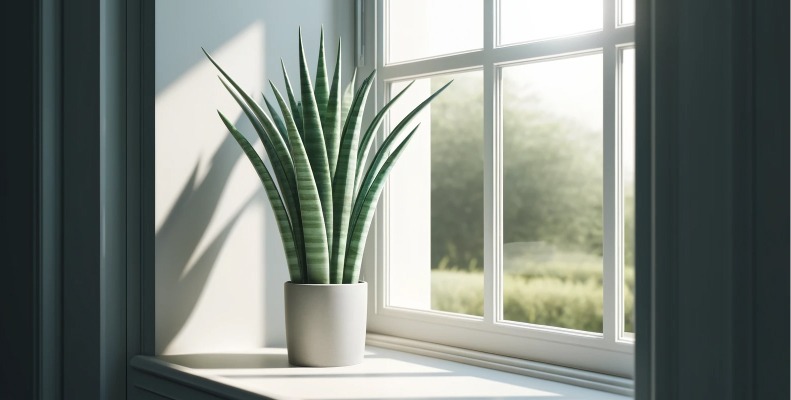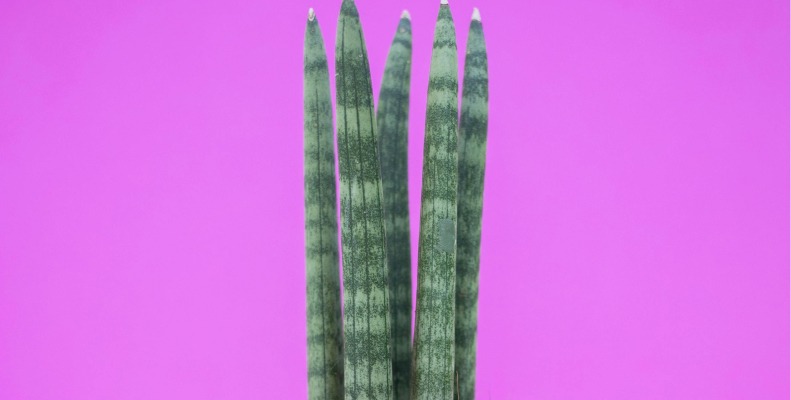Want to make your place more elegant? The African spear plant is a great pick. It’s also known as the cylindrical snake plant. This plant from Africa has long, spear-like, gray-green leaves. It grows straight up, often getting as tall as 4 to 6 feet. We’ll talk about how to take good care of it in this guide.
Key Takeaways:
- The African spear plant, also known as the cylindrical snake plant, is a succulent houseplant native to Africa.
- It requires sandy, well-draining soil and prefers morning sun to afternoon sun.
- Watering should be infrequent, allowing the soil to dry out completely between waterings.
- The plant can tolerate a range of light conditions, from low light to full sunlight.
- Propagation can be done through division or by replanting offshoots that emerge from the parent plant.
Common Names and Botanical Information
The African spear plant is also called the cylindrical snake plant or spear sansevieria. It’s a cool succulent from the Dracaena family. The plant’s scientific name is Dracaena angolensis, even though it used to be Sansevieria cylindrical. It can get up to 4-6 feet tall and 1-2 feet wide, perfect for indoor areas.
This plant stands out because of its spear-shaped leaves. They are gray-green with light stripes. The leaves stand up straight, giving it an elegant look. The unique leaves and colors really make it eye-catching.
The African spear plant can fit in many different places. It’s good for people who love plants and for those just starting out. It’s easy to take care of and looks great in any home or office.
Interesting Fact:
The African spear plant is often used in traditional medicine. People believe it can help heal burns and skin problems.
Sun and Soil Requirements
The African spear plant likes different light levels. It can handle low light but does best in full to partial sun. It enjoys bright, indirect sunlight or a north-facing window. This way, it stays well-lit but not too hot.
For the right growth, the plant needs special soil. It likes soil that drains well, like its home in sandy places. You should use soil made for succulents or cacti. This type of soil helps the plant avoid getting too much water, which can harm it.
By giving it the right sun and soil, your African spear plant will thrive. It will be healthy and grow well for a long time.
Tip:
If you’re not sure about your soil’s drainage, add perlite or sand. This helps the soil drain better. Also, water the plant a lot but let the soil become dry before watering again. This keeps the plant from getting too much water.
| Sun Exposure | Soil Requirements |
|---|---|
| Full to partial sun | Well-draining soil |
| Tolerates low light conditions | Specifically designed potting mix for succulents or cacti |
Watering and Fertilizing Tips
Watering and feeding your African spear plant right is key for its health. Here’s how to make sure it gets the water and nutrients it needs.
Watering:
The African spear is a succulent, so it doesn’t need much water. Oh, and let the soil dry fully between waterings. This keeps it healthy, much like in the wild where it faces drought.
Always water by the roots deeply for best growth. But, watch out for too much water, which can hurt the roots. Never let the plant stand in water, to avoid this issue.
Fertilizing:
Your African spear doesn’t need lots of feeding, but it enjoys a little succulent fertilizer sometimes. A monthly dose in the spring and fall is perfect for its nutrients.
Choose a fertilizer made for succulents and mix it half strength. This keeps the plant from getting too much. And, remember, no feeding in winter when it rests.
To keep your African spear plant healthy, follow our watering and fertilizing tips. These will help it get only what it needs to thrive.
Done with water and food tips? Next, let’s talk about the light and temperature the African spear plant loves.
| Watering | Fertilizing |
|---|---|
| African spear plant requires infrequent watering | Occasional feeding with a succulent fertilizer |
| Allow the soil to dry out completely between waterings | Use a succulent-specific fertilizer diluted to half strength |
| Water deeply when watering | Apply the fertilizer once a month from spring to fall |
| Avoid overwatering to prevent root rot | No fertilization is necessary during winter |
Light and Temperature Requirements
The African spear plant can handle many light levels. This makes it a good pick for various places. While it can live in low light, it prefers bright, indirect light.
It does its best with morning sun. Yet, watch out for hot afternoon sun. It can hurt the plant by burning its leaves.
This plant likes warm, stable temperatures. Keep it above 50 degrees Fahrenheit. Since it’s used to hot, dry places, avoid cold drafts. These can shock the plant and slow its growth.
“Providing the right balance of light and temperature is essential for the African spear plant’s well-being. By ensuring adequate light exposure and maintaining suitable temperatures, you can create the ideal conditions for its growth and longevity.”
Lighting Tips:
- Place the African spear plant in a well-lit area with bright, indirect light.
- Avoid exposing the plant to direct hot afternoon sun, as it can cause damage.
- Consider placing the plant near a north-facing window for optimal light exposure.
Temperature Tips:
- Maintain temperatures above 50 degrees Fahrenheit (10 degrees Celsius) for the African spear plant.
- Avoid exposing the plant to cool drafts, such as those from air conditioners.
- Keep the plant away from cold windows or doors that may cause temperature fluctuations.
| Light Exposure | Temperature Range | Recommended |
|---|---|---|
| Low light | Above 50°F (10°C) | ✔ |
| Bright, indirect light | Above 50°F (10°C) | ✔ |
| Morning sun | Above 50°F (10°C) | ✔ |
| Direct hot afternoon sun | Above 50°F (10°C) | ✘ |
| Variations in temperature | Below 50°F (10°C) | ✘ |
Propagation and Pruning
The African spear plant is great for cloning and keeping its look nice. It can be cloned in a few ways and cut back for a good shape.
Propagation:
In the spring, it’s a good time to make more plants. You can do this by cutting it into parts or using new shoots. This is when the plant is super ready to grow.
For cutting it into parts, pull it out of the pot gently. Then, pull apart the stems or roots. Make sure each part has roots. Put these in soil that drains well and don’t forget to water. Soon, you’ll see new plants growing.
You can also grow more plants by cutting off the side shoots. With a clean knife, cut these new shoots near the base of the main plant. Next, put these shoots in their own pots with soil that drains well. Water them like you would for any plant.
Pruning:
Pruning helps the African spear plant stay healthy and look good. You should take off leaves that are turning yellow or brown. These are at the bottom of the plant.
Also, you could twist the long leaves into a braid. This not only looks cool but also stops the plant from getting too big. It keeps it nice and neat.
“Pruning is an essential aspect of caring for the African spear plant and helps to maintain its overall health and appearance.”
Pests and Diseases
The African spear plant is tough and can fight off many pests and diseases. Yet, it can sometimes get mealybugs or spider mites. These bugs are common and can harm your plant.
Mealybugs are tiny, covered in white, and soft. They eat the plant’s sap and can hurt your African spear plant. If you see them, act quickly to stop more from coming.
Insecticidal soap works well against mealybugs. Mix the soap with water following the package’s guide. Then, put it on the plant where the bugs are. Keep doing this until they’re gone.
Root rot is another problem these plants might face. This happens when roots are too wet for too long. If drainage isn’t good, or you give the plant too much water, roots can start to die.
To avoid root rot, water your plant correctly. Wait for the soil to dry before watering again. Also, use special soil that drains well and a pot that lets water out.
Keep an eye on your African spear plant for bugs and diseases. Then, act fast with the right treatment. This way, your plant will stay healthy.
| Pest/Disease | Symptoms | Treatment |
|---|---|---|
| Mealybugs | White, waxy clusters on leaves, stems, and roots | Apply insecticidal soap as directed on packaging |
| Root Rot | Yellowing or wilting leaves, mushy or blackened roots | Ensure proper watering practices and use well-draining soil |
Conclusion
The African spear plant isn’t just a succulent – it’s a bold piece for your home. It brings beauty and style with its unique look. With the right care for light, water, and soil, you can help it flourish.
This plant is also very versatile. You can braid its leaves for fun or grow new plants from the old ones. It’s a great choice for anyone who loves plants and getting creative.
But, this plant is dangerous to pets. If you have animals at home, keep the plant in a pet-proof area. This keeps both your pets and the plant safe.
Its beautiful look and easy care make the African spear plant perfect for indoor spaces. It brings peace and natural charm. So, welcome its beauty in your life and space!


